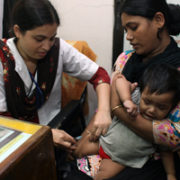Archive | Blog RSS feed for this section
Economics
 Energy
Energy
 Finance sector development
Finance sector development
 Health
Health
 Economics, Finance sector development
Economics, Finance sector development
 Industry and trade
Industry and trade
 Economics
Economics
 Finance sector development, Industry and trade
Finance sector development, Industry and trade
 Economics
Economics
 Finance sector development, Information and Communications Technology
Finance sector development, Information and Communications Technology

Spillover effects of Japan’s unconventional monetary policy on emerging Asia

Like other central banks in advanced countries, the Bank of Japan (BOJ) adopted an unconventional monetary policy after the 2007–2009 global financial crisis (GFC). After Prime Minister Abe advocated the new policy regime, Abenomics, the BOJ became highly aggressive in its unconventional policy (see, for example, Fukuda [2015] for details). On 4 April 2013, BOJ Governor Kuroda introduced quantitative and qualitative monetary easing (QQE) and committed to achieve a 2% inflation target in 2 years.
Decline of oil prices and the negative interest rate policy in Japan

In February 2016, the Bank of Japan (BOJ), in order to reach a 2% inflation target, initiated a negative interest rate policy by increasing massive money supply through the purchase of long-term Japanese government bonds (JGBs). This policy flattened the yield curve of JGBs. Banks started to purchase government bonds less frequently, because of the negative yield for both short-term government bonds and even for long-term government bonds up to 15 years. On the other hand, a vertical investment–savings curve in the Japanese economy prevented the growth of corporate bank loans. Except for a few periods, the 2% inflation target could not be achieved. This paper examines this phenomenon, presents the reasons behind it, and offers solutions.
The institutionalization of the credit surety fund in the Philippines

The local business community is upbeat with the passing into law of Republic Act 10744, otherwise known as the Credit Surety Fund Cooperative Act of 2015 on 6 February 2016. Essentially, the said law provides for the creation and organization of the Credit Surety Fund (CSF) cooperatives to manage and administer credit surety funds and to enhance the accessibility of micro, small, and medium-sized enterprises (MSMEs); cooperatives; and nongovernment organizations (NGOs) to bank credit facilities.
Innovation in health care in South Asia

The countries comprising the South Asian Association for Regional Cooperation (SAARC) region (India, Pakistan, Bangladesh, Nepal, Bhutan, Afghanistan, Sri Lanka, and the Maldives) commonly known as South Asia face serious healthcare affordability and accessibility challenges. According to World Bank national estimates, South Asian countries houses more than 390 million poor people and a very significant percentage of total population lies below national poverty line (Figure 1). This large number of population is quite unlikely to afford private healthcare services and heavily dependent on the public healthcare facilities.
Does internal and external research and development affect innovation of small and medium-sized enterprises? Evidence from India and Pakistan

Small and medium-sized enterprises (SMEs) play a vital role in the economic growth of a country. Specifically, in developing countries where poverty, unemployment, low income per capita, low literacy rate, and high inflation and interest rates can hinder economic growth, SMEs contribute significantly to the national income and provide employment opportunities (Moktan 2007). However, SMEs have low survival rates than large firms because of resource constraints.
What can we learn from the trade and growth nexus in the Republic of Korea?

Since trade started being emphasized as a locomotive of growth, export promotion trade policies have become a popular option for countries in search of higher economic growth rates. East Asian countries in particular have witnessed a distinct success in terms of rapid economic growth after the adoption of outward-looking trade policies.
Some knowledge economy lessons from the Republic of Korea for Africa

Twenty-first century competition is centered on the knowledge economy, with Europe and North America inexorably charting the course of development in the international arena. In calculated steps, Latin America and Asia have been asserting the need for enhanced knowledge economy strategies in their own pursuits of national and regional development.
Digitizing trade – how changing the process is changing development

Over 31 million consumers in Viet Nam researched or purchased a product online in 2015. Just ten years ago, internet connectivity was only starting to become common. Digitization is changing how people trade. There are even more dramatic changes happening under the hood. The way trade is financed, processed and regulated has entered a period of disruption. We take this opportunity to consider the short and long term implications of digitization of the trade process. They’re not what you’d expect.
Uncertainty about Federal Reserve policy and its transmission to emerging economies: Evidence from Twitter

If the United States Federal Reserve tightens or eases monetary conditions, this impacts emerging economies. Over the years since the global financial crisis, a second type of spillover has emerged: spillovers stemming from the uncertainty about future monetary policy. Uncertainty spillovers exist above and beyond those stemming from specific policy steps. It is the uncertainty about the likely course of monetary policy that led investors to adjust their portfolios, thus leading to side effects on emerging markets.
Technology and innovation for SMEs: Policy lessons from East Asia

Small and medium-sized enterprises (SMEs) in developing economies often have difficulties improving their technological capabilities in terms of product or process innovation. Therefore, some kind of government support is necessary.


Search
Subscribe / Connect to Asia Pathways
Subjects
- Agriculture and natural resources
- Blog
- Capacity development
- Climate change
- Economics
- Education
- Energy
- Environment
- Finance sector development
- Gender
- Governance and public sector management
- Health
- Industry and trade
- Information and Communications Technology
- Infrastructure
- Miscellaneous
- Population
- Poverty
- Private sector development
- Regional cooperation and integration
- Sanitation
- Social development and protection
- Transport
- Uncategorized
- Urban development
- Video Blog
- Water
Recent Posts
- Artificial intelligence: A new driver for inclusive growth and development?
- Increasing trust in cross-border e-commerce and artificial intelligence
- Enhancing access to maternal and newborn healthcare in developing Asia
- Can electric vehicles lead the way to a sustainable future?
- Mitigating climate-related sovereign risk to accelerate action on the climate emergency




Recent Comments